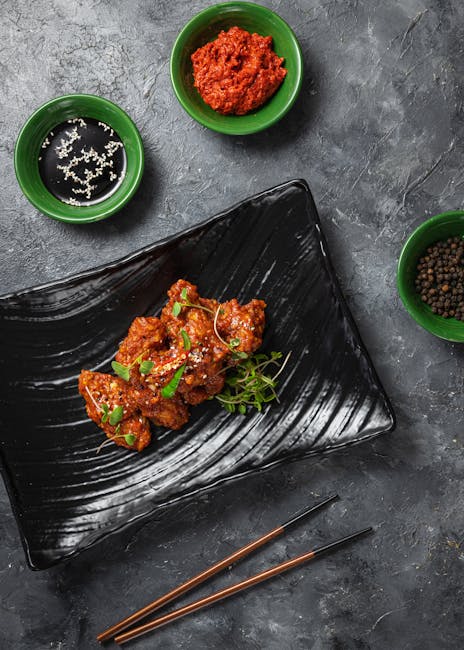Introduction
Bibimbap, translating literally to “mixed rice,” is a cornerstone of Korean cuisine. This vibrant and flavorful dish typically features a bed of warm rice topped with an array of seasoned vegetables, a protein source (often beef, chicken, or tofu), and a fried egg. But the true magic of bibimbap lies in its gochujang sauce – a fermented chili paste that brings a fiery kick and umami depth to the entire bowl. This article dives into the world of Korean bibimbap with gochujang sauce, exploring its ingredients, preparation, and variations.
The Anatomy of a Bibimbap Bowl
The Rice Base
The foundation of any good bibimbap is perfectly cooked rice. Short-grain white rice is the traditional choice, offering a slightly sticky texture that helps bind all the ingredients together. Brown rice can also be used for a healthier alternative.
The Colorful Vegetables
A rainbow of vegetables not only makes bibimbap visually appealing but also provides a wealth of nutrients. Common vegetables include:
- Julienned carrots: Offer sweetness and crunch.
- Sautéed spinach: Provides a subtle earthy flavor.
- Bean sprouts: Adds a refreshing crispness.
- Shiitake mushrooms: Contribute a savory umami element.
- Kimchi: Adds a fermented tang and spicy kick (optional).
- Radish (Daikon): Offers a mild and slightly peppery flavor.
- Cucumber: Provides a cool and refreshing contrast.
Each vegetable is typically seasoned individually to highlight its unique flavor.
The Protein Component
While bibimbap can be vegetarian, a protein source adds substance and richness. Popular choices include:
- Thinly sliced beef (Bulgogi): Marinated and grilled for a sweet and savory flavor.
- Ground beef: Seasoned with soy sauce, garlic, and ginger.
- Chicken: Grilled or stir-fried.
- Tofu: For a vegetarian and vegan option, tofu can be marinated and pan-fried or air-fried.
The Perfect Egg
A fried egg, often with a runny yolk, is the crowning glory of a bibimbap bowl. The yolk adds richness and creaminess, coating the rice and vegetables as you mix everything together.
Gochujang Sauce: The Heart of Bibimbap
Gochujang is a Korean fermented chili paste made from red chili powder, glutinous rice, fermented soybeans, and salt. It’s the key ingredient that elevates bibimbap from a simple rice dish to a flavor explosion. Gochujang offers:
- Spicy heat: The level of spiciness can vary depending on the brand and batch.
- Umami depth: Fermentation brings a complex savory flavor.
- Subtle sweetness: A touch of sweetness balances the spice.
Often, gochujang is mixed with sesame oil, vinegar, and sugar to create a balanced and palatable sauce.
Making Your Own Bibimbap: A Step-by-Step Guide
- Prepare the rice: Cook short-grain white rice according to package directions.
- Prepare the vegetables: Wash, chop, and season each vegetable individually. Sauté or lightly stir-fry most vegetables, except for raw options like cucumber.
- Cook the protein: Marinate and cook your chosen protein.
- Fry the egg: Fry an egg to your desired doneness, ideally with a runny yolk.
- Make the gochujang sauce: Combine gochujang, sesame oil, vinegar, and sugar to taste.
- Assemble the bowl: Place the cooked rice in a bowl. Arrange the vegetables and protein attractively on top. Place the fried egg in the center.
- Drizzle with gochujang sauce: Add as much or as little sauce as you like.
- Mix and enjoy: Use your chopsticks or a spoon to thoroughly mix all the ingredients together before eating.
Bibimbap Variations
Dolsot Bibimbap
Dolsot bibimbap is served in a hot stone bowl. The heat of the bowl crisps the rice at the bottom, creating a delightful crunchy texture. This version is especially popular in the colder months.
Yukhoe Bibimbap
This variation features seasoned raw beef (yukhoe) as the protein component. It’s a delicacy for those who enjoy the unique texture and flavor of raw beef.
Vegetarian/Vegan Bibimbap
Easily adaptable for vegetarian and vegan diets by using tofu or other plant-based proteins and ensuring all ingredients are free of animal products.
Conclusion
Korean bibimbap with gochujang sauce is more than just a meal; it’s an experience. The combination of vibrant colors, contrasting textures, and explosive flavors makes it a dish that delights the senses. Whether you’re a seasoned Korean food enthusiast or a curious newcomer, bibimbap is a must-try. So, gather your ingredients, prepare your gochujang sauce, and embark on a culinary adventure to create your own perfect bibimbap bowl!
